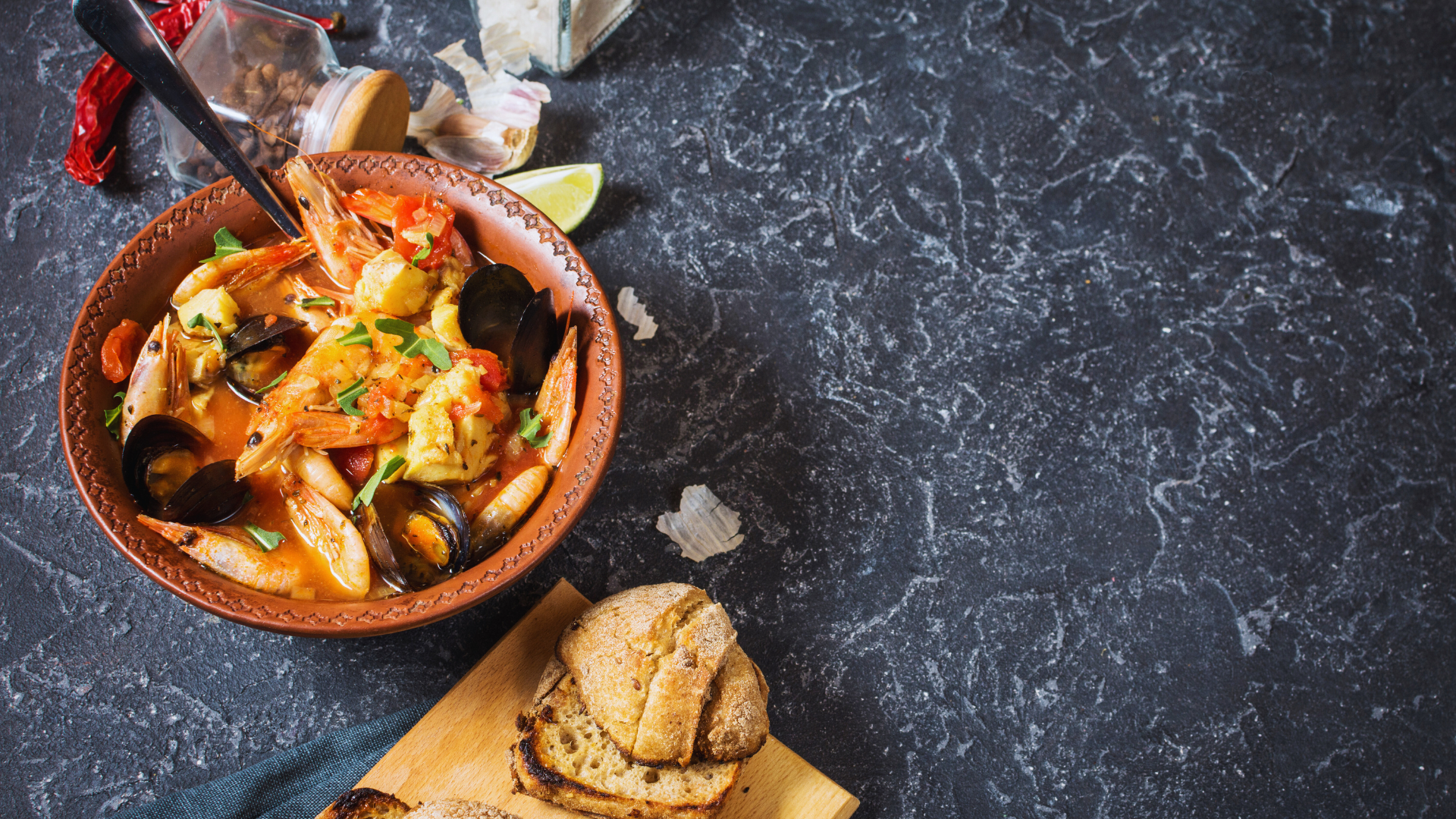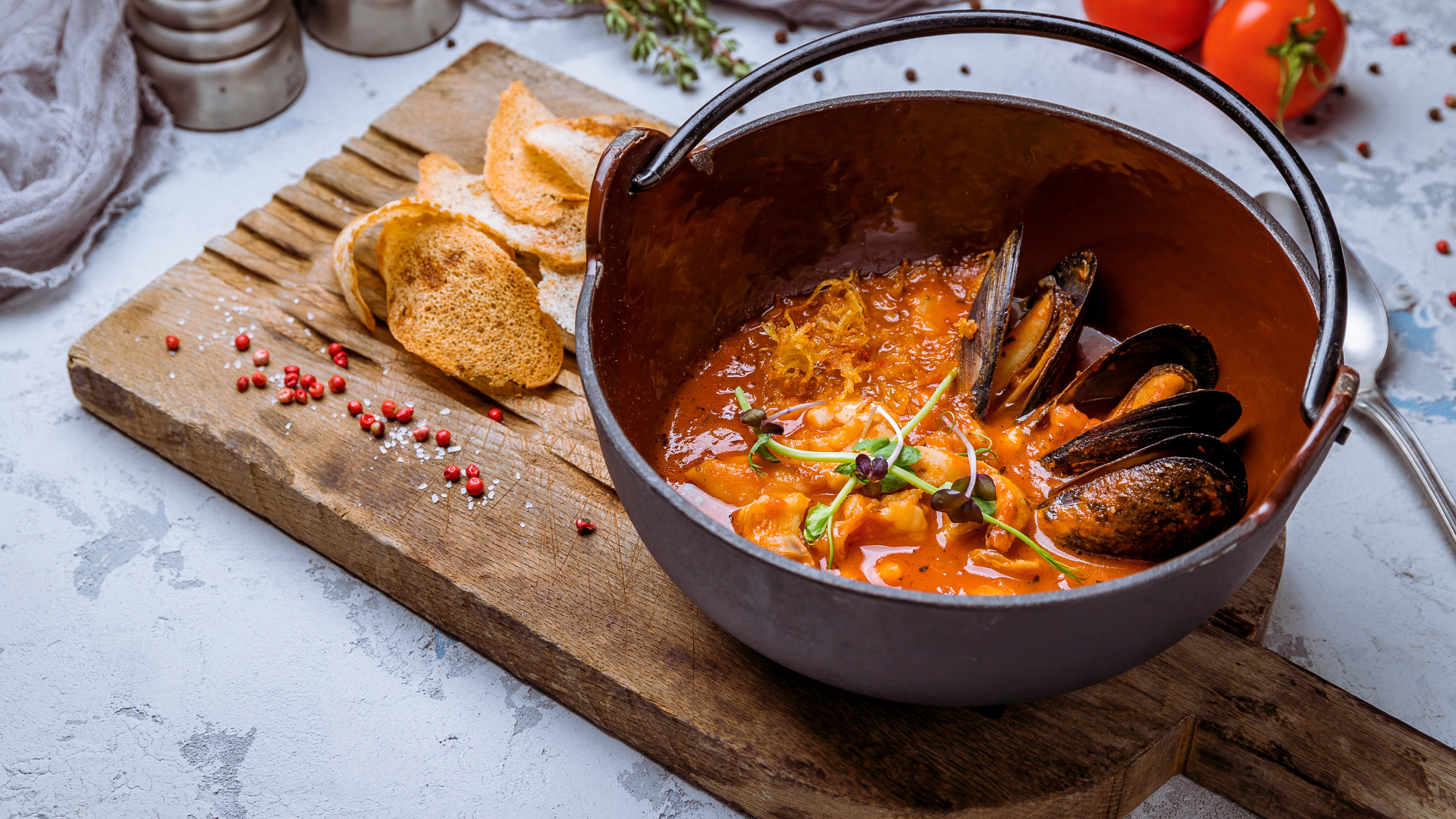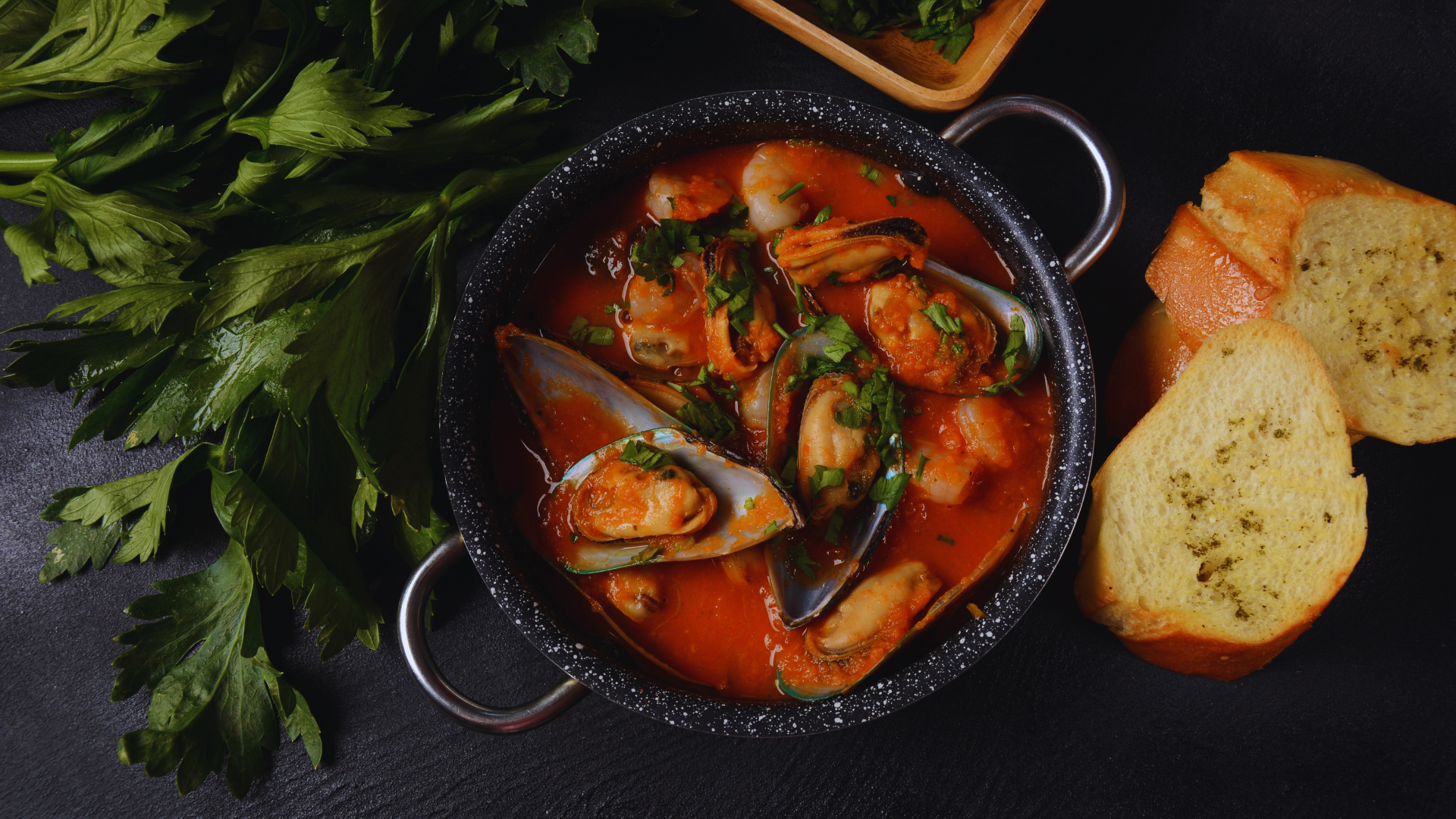Bouillabaisse: History and Recipe

History of Bouillabaisse
Bouillabaisse is a traditional fish stew that originated in the port city of Marseille, in the Provence region of southern France. Its roots lie in the humble meals of Provençal fishermen, who used whatever fish they couldn’t sell at the market. The name "bouillabaisse" comes from the Provençal Occitan words "bolhir" (to boil) and "abaissar" (to reduce heat), referring to the technique of bringing the broth to a boil and then simmering it.
Bouillabaisse has several regional and modern variations, each reflecting the local ingredients and culinary traditions of different areas. While the dish originated in Marseille, its concept has spread across France and beyond. Here are some of the notable varieties:
Bouillabaisse Parisienne (Parisian Bouillabaisse)
Key Ingredients: This version, made far from the Mediterranean coast, often uses fish from the Atlantic or North Sea rather than the traditional Mediterranean varieties. It might include cod, lobster, and langoustines.
Serving Style: It follows the same general method as the Marseille version, though the flavor profile can differ due to the different types of fish and seafood
Bouillabaisse de Sète
Key Ingredients: Hailing from the fishing town of Sète, this version typically includes fewer types of fish and more shellfish (such as cuttlefish, squid, and octopus) compared to the Marseille variant. Tomatoes are a key ingredient, and it tends to have a thicker, richer texture.
Distinctive Feature: It's more tomato-based, reflecting the local preference for robust stews.
Sticking with the classic bouillabaisse recipe is the best way to appreciate its authentic flavors. Here are some additional details that focus on the essential elements of this iconic version:
Key Elements of a Classic Bouillabaisse
The Fish: The heart of the dish is the combination of Mediterranean fish. Traditional bouillabaisse typically includes:
Rascasse (a bony rockfish, vital for the authentic flavor)
Red mullet (adds richness)
John Dory
Sea bass
Conger eel
You can mix these with shellfish such as mussels, clams, and prawns. Depending on availability, you can use any firm, white-fleshed fish as substitutes.
Bouillabaisse à la Niçoise
Key Ingredients: Found in Nice and other parts of the French Riviera, this version may include more vegetables like zucchini and bell peppers, along with a wider array of shellfish (shrimp, crab, langoustines).
Distinctive Feature: Compared to the Marseille version, it's often lighter, with more vegetables and less of the intense saffron flavor.
Modern/Creative Bouillabaisse
Key Ingredients: Some modern chefs reinterpret bouillabaisse by incorporating non-traditional ingredients such as lobster, scallops, and clams, or even using non-Mediterranean fish.
Distinctive Feature: These versions play with the concept, sometimes offering a deconstructed bouillabaisse, with the fish and broth served separately in avant-garde presentations.
Bouillabaisse à la Provençale
Key Ingredients: A regional twist where local Provençal herbs like thyme and rosemary feature prominently. Tomatoes, olives, and sometimes a splash of pastis (an anise-flavored spirit) are added.
Distinctive Feature: The use of Provençal herbs and pastis gives it a distinctive aromatic quality.
Cioppino
Key Ingredients: Although not a true bouillabaisse, cioppino is an Italian-American seafood stew from San Francisco with clear Mediterranean roots, often compared to bouillabaisse. It includes crab, clams, shrimp, and tomatoes, typically served with sourdough bread.
Distinctive Feature: Unlike bouillabaisse, it often features fewer types of fish but includes more shellfish and is generally more tomato-heavy.

While each variation stays true to the concept of a rich, fish-based broth and seafood, the types of fish and shellfish used, as well as the balance of flavors, may vary greatly depending on the region and chef's interpretation.

Origins and Evolution:
Fisherman’s Stew: Bouillabaisse was originally a simple, rustic dish, made by fishermen who boiled leftover fish with herbs and seawater. They would eat the dish with bread while they were out at sea.
Regional Influence: As Marseille grew as a bustling Mediterranean port, the dish evolved, absorbing influences from traders and neighboring countries, particularly those around the Mediterranean.
Modern Times: Over time, bouillabaisse has been refined into a more sophisticated dish, sometimes featuring lobster, langoustines, or other expensive seafood. However, its soul remains in the humble origins of the fishermen’s stew.
A true bouillabaisse is defined by its specific combination of Provençal herbs and spices and a variety of Mediterranean fish, but it is the broth, rich with garlic, saffron, and olive oil, that gives it its distinctive flavor.
Classic Bouillabaisse Recipe
Ingredients:
For the Soup:
2 tablespoons olive oil
2 medium onions (sliced)
4 cloves garlic (minced)
1 leek (white part only, sliced)
1 fennel bulb (sliced)
4 ripe tomatoes (chopped or 1 can diced tomatoes)
1 small bunch of fresh parsley
1 small bunch of fresh thyme (or 1 teaspoon dried thyme)
1 bay leaf
1 pinch saffron threads
1/2 teaspoon fennel seeds
4 cups fish stock (or water)
Salt and pepper to taste
1 1/2 pounds assorted Mediterranean fish (such as red mullet, sea bass, John Dory)
12 mussels or clams
8 prawns or langoustines
4 medium squid (cleaned and cut into rings)
For the Rouille (Traditional Garlic Sauce):
1 egg yolk
2 cloves garlic (crushed)
1/2 teaspoon cayenne pepper (optional)
1/2 teaspoon saffron threads (steeped in 1 tablespoon warm water)
1/2 cup olive oil
Salt to taste
1 slice of white bread (soaked in water and squeezed dry)
For Serving:
Crusty bread (baguette, sliced and toasted)
Instructions:
Prepare the Broth:
Heat olive oil in a large, heavy-bottomed pot over medium heat.
Add sliced onions, leeks, fennel, and garlic. Sauté for about 10 minutes until softened and fragrant.
Add chopped tomatoes, parsley, thyme, bay leaf, saffron, and fennel seeds. Stir and cook for another 5 minutes.
Pour in the fish stock (or water) and bring to a boil. Reduce heat and simmer for 20 minutes to let the flavors blend.
Prepare the Seafood:
Clean and prepare the fish (whole fish are traditionally used, cut into large pieces).
Clean the mussels or clams and set aside.
Cut the squid into rings.
Peel the prawns or langoustines, leaving the heads on for added flavor if desired.
Cook the Seafood:
Add the fish pieces into the simmering broth and cook for about 10-15 minutes, depending on the size of the fish.
Add the squid, prawns, and mussels in the last 5-7 minutes of cooking. Simmer until the mussels open and the seafood is cooked through.
Prepare the Rouille:
In a bowl, mash the garlic and soaked bread together to form a paste.
Add the egg yolk, cayenne (optional), and saffron (with the water it was steeped in).
Slowly drizzle in olive oil, whisking constantly, to create a thick sauce. Season with salt to taste.
Serve:
Serve the bouillabaisse by placing the seafood in large bowls and pouring the broth over the top.
Accompany with slices of toasted baguette spread with the rouille.
Alternatively, the broth can be served separately with the rouille spread on the bread, followed by the fish served on a platter.

Tips for Making Bouillabaisse:
Fish Variety: A proper bouillabaisse requires a variety of Mediterranean fish. If you can’t source these, aim for firm white fish (such as cod, haddock, or halibut) along with shellfish like shrimp or mussels.
Broth Richness: The key to a good bouillabaisse is the broth. The saffron and fennel give it a unique taste, and it should have a rich, complex flavor.
Rouille: This garlicky sauce is essential to authentic bouillabaisse. It adds richness to the dish and can be adjusted for spiciness.
Serving Suggestions: Bouillabaisse is traditionally served with rouille on the side and plenty of crusty bread. It’s best enjoyed as a main course with a glass of chilled white wine from Provence, such as a crisp Côtes de Provence or a Bandol Blanc.





